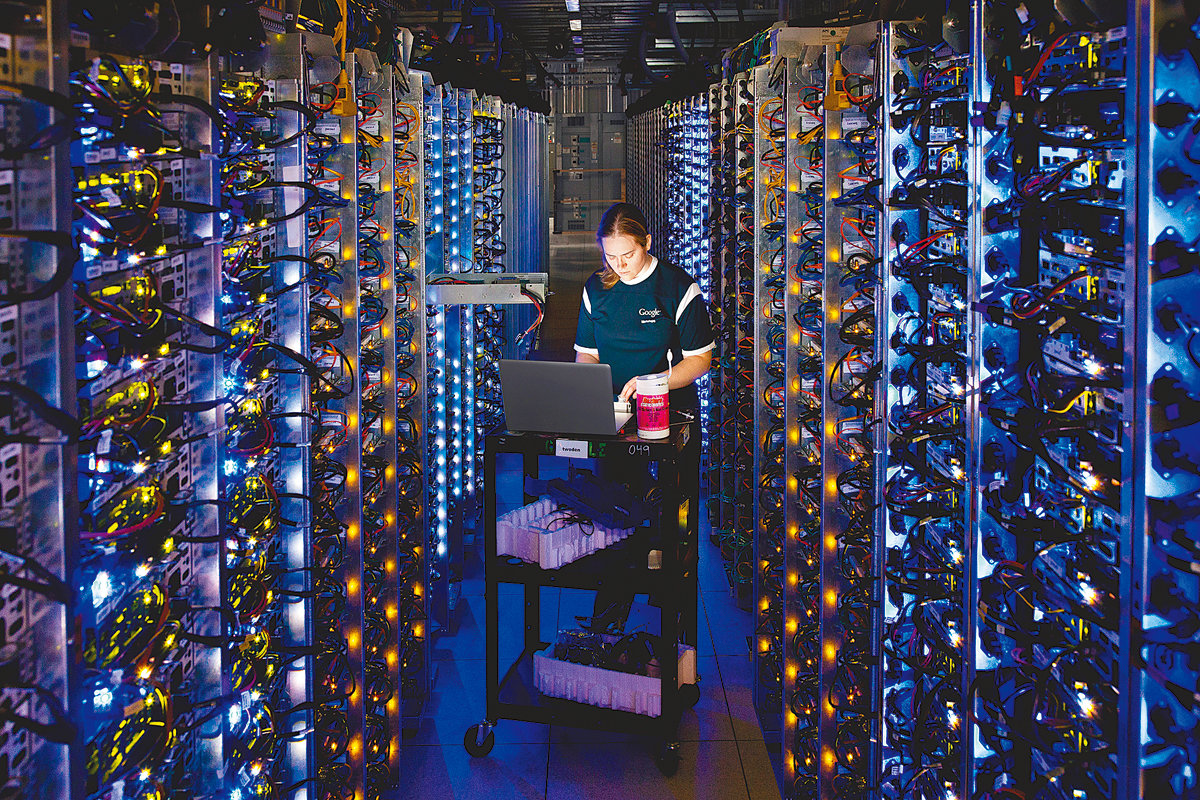[토요기획] How to cool down a ‘fireball’ data center
Data center power usage 45%… Used to cool down overheated servers
Heat problem, IT company’s fire… Nvidia installs cooling pipes
Development of immersion cooling by SK Nmove… Microsoft promotes undersea data centers
Waste heat is used for heating and freezing prevention… Pay attention to innovative ideas
《’Cool down the fireball data center.’
In Nvidia’s fiscal second quarter (April to June) performance announcement in August, there was something that attracted as much attention as the next-generation artificial intelligence (AI) accelerator ‘Blackwell’. It was the announcement of the introduction of the ‘liquid cooling’ method. NVIDIA declared on this day, “We will design Blackwell based on liquid cooling to reduce data center power consumption by up to 28%.”
An employee diagnoses an overheated server at a Google data center in Dallas, Oregon, USA. Photo source: Google homepage
● Companies in the AI era, ‘war against fever’
From a smartphone in the hand to a work PC, everyone has experienced the device becoming hot when using a high-performance program for a long period of time. It is natural for data centers of information technology (IT) companies, which are densely equipped with high-performance central processing units (CPUs) and graphics processing units (GPUs), to experience heat problems. According to the semiconductor industry, about 45% of the power used in a data center goes into air conditioning devices and cooling fans that reduce server heat.
As demand for data center servers rapidly increases in the AI era, the market for data center cooling, which is essential to maintain stability, is also growing. According to Fortune Business Insight, the global data center cooling market size is expected to grow from $14.85 billion (about KRW 20.5465 trillion) last year to $30.31 billion (about KRW 41.9369 trillion) in 2030.
Until recently, the data center cooling method that most IT companies, including NVIDIA, have adopted is air cooling. Simply put, it is an air conditioning device like an air conditioner that circulates cold air between servers to cool down the heat. As the data center market expands, leading companies in the existing cooling and heating industry are also jumping into the market. Last month, the U.S. carrier declared, “We will begin full-scale data center cooling business, which is growing rapidly along with the development of AI technology.” LG Electronics, which is expanding its heating and cooling business, is also targeting the data center market with high-efficiency chillers.
However, air cooling technology has a relatively low initial installation cost, but has the disadvantage of generating noise and high power consumption. A lot of land is needed to install an air conditioner. Accordingly, as with this Nvidia announcement, liquid cooling is attracting attention as a new technology.
The liquid cooling method mainly refers to installing pipes through which cooling liquid flows into the server. It takes up less space and has higher cooling efficiency than air cooling, but the initial installation cost is very expensive. According to Morgan Stanley, a global investment bank (IB), the cost of the liquid cooling system to be applied to NVIDIA Blackwell servers alone amounts to about 100 million won per server. It is up to 20 times more expensive than the cooling cost of existing products using air cooling.
Nevertheless, considering the rapidly rising server demand in the AI era, there is a growing expectation that liquid cooling will achieve cost efficiency in the long term. NVIDIA CEO Jensen Huang said in a conference call announcing second quarter earnings, “In liquid-cooled data centers, we can increase AI throughput by three to five times compared to the past, no matter what size data center you choose.” . This means that server capabilities, which are currently limited by heat and power issues, can be further expanded.
● Immersion cooling and submarine data centers appear
An underwater server used in Microsoft’s underwater data center project ‘Natic’, which was carried out from 2018 to June of this year, was salvaged from the Orkney Islands in Scotland. Photo source: Microsoft website Liquid immersion cooling technology, which goes one step further from the simple liquid cooling method, is also attracting attention. This method involves waterproofing the server itself and then submerging it in cooling liquid. In this case, it is efficient because pipes required for existing liquid cooling can be eliminated, but the difficulty of technology development increases further.
According to related industries, NVIDIA has already established an in-house team dedicated to immersion cooling and has begun developing the technology. It attracted attention by recruiting engineers with a master’s or doctoral degree in chemistry and materials science to work on the team starting in August. In May of last year, Intel also announced that it would cooperate with GRC, an American immersion cooling startup, and invest a total of $700 million (approximately KRW 968.4 billion) in the development of immersion cooling technology.
Last year, SK NMove, a subsidiary of SK Innovation, announced that it would join hands with the U.S. GRC company to develop data center immersion cooling system technology. Provided by SK Nmove Domestic companies have also jumped into the development of immersion cooling technology. SK Innovation’s subsidiary SK nMove previously developed Korea’s first cooling fluid in 2022 and also made an equity investment worth $25 million (about KRW 34.6 billion) in GRC. In November last year, an immersion cooling oil facility was demonstrated at SK Telecom’s AI data center. LG Electronics, which entered the data center cooling market with air conditioning and heating, is also paying attention to immersion cooling. Lee Jae-seong, vice president and head of LG Electronics’ Air Solutions Business Division, said at the Investor Forum in September, “The Chief Technology Officer (CTO), LG Electronics Production Technology Institute, and LG Group affiliates are quickly preparing to commercialize solutions such as immersion cooling through our technology.” “We are also actively working to establish partnerships with global professional companies,” he said.
There are also attempts to go one step further and use the ocean, a ‘natural coolant that does not need to be replaced’. This is a challenge to overcome the ultimate disadvantage of land-based data centers, which is power consumption, by utilizing the natural cooling effect of sea water by installing a data center on the seabed.
Microsoft (MS) has been carrying out the undersea data center operation project ‘Natic’ off the coast of Scotland from 2018 to June of this year. This is a project to study performance in various situations by sealing 855 servers in metal containers and submerging them in the sea. Although it did not lead to final commercialization, it achieved results by comparing the failure rate with terrestrial data centers and revealing that undersea centers are more efficient.
Highlander, a Chinese data center company, also began experimenting with undersea data centers. We plan to install 100 server modules, the size of 13 soccer fields, under the sea near Hainan Island, China, by next year. The company said, “With seawater acting as a coolant, we will be able to save about 122 million kWh (kilowatt hours) of electricity usage, equivalent to the amount of electricity used by 160,000 Chinese citizens in a year.”
● “Heating with data center waste heat” Attention to heat recycling industry
As a change of idea, how about using the heat generated in the data center itself? There are also cases where such ideas have been created in niche areas of the data center cooling market. This is the data center ‘heat recycling’ industry.
A representative example is Google’s Finnish data center experiment. In May, Google announced plans to invest 1 billion euros (about 1.4967 trillion won) to expand its Finnish data center, saying, “The heat from the Finnish data center will be used to heat the nearby city of Hamina, including local homes, schools and public service buildings.” “It will be supplied to the district heating network,” he said. “We aim to achieve net zero emissions across all operations and value chains by 2030.”
This is based on heat exchange technology and heating energy transfer technology developed locally in Finland. This method sends the coolant heated by the server to the district heating system, then recovers it and circulates it to the data center. Not only Google but also Microsoft is pursuing a plan to build a data center in the Helsinki area and supply waste heat for district heating.
In Korea, Naver and Kakao attempted this experiment. Naver is using the waste heat from its data center ‘Gak’ in Chuncheon, Gangwon-do not only for local heating, but also for greenhouses and preventing road icing in winter. Kakao is also reusing waste heat from its data center in Ansan, Gyeonggi Province, for heating. Korea District Heating Corporation also signed a business agreement with Aegis Asset Management in September to utilize waste heat and began recycling waste heat from urban data centers.
Choi Bo-young, an IT and semiconductor researcher at Kyobo Securities, said in a report, “About half of the power in a data center is used to cool down the heat,” and added, “In the future, it will be important for semiconductors to develop technologies that can reduce power as well as fast computing capabilities. “In particular, the importance of technology for cooling solutions is increasing.”


